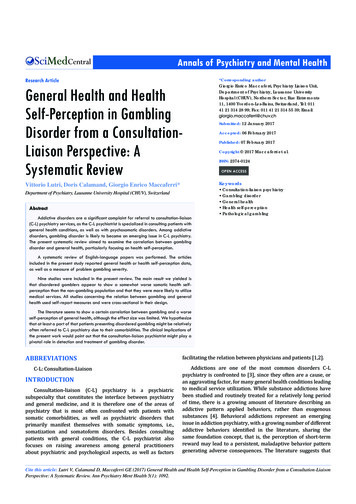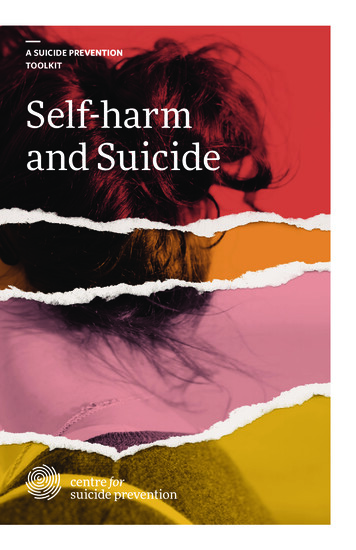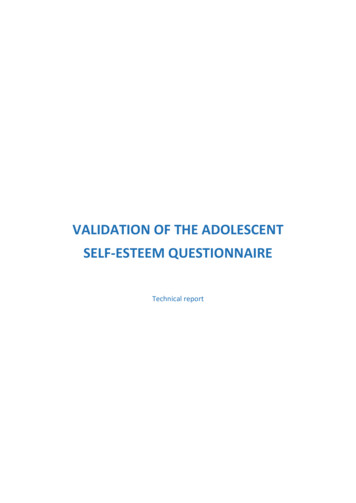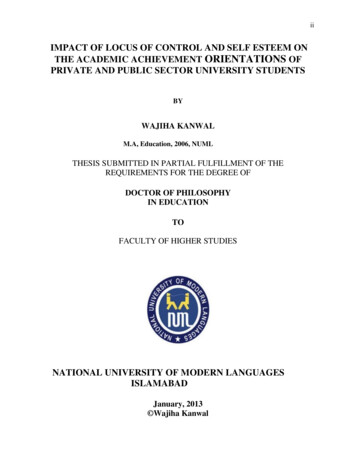
Transcription
CentralAnnals of Psychiatry and Mental HealthResearch ArticleGeneral Health and HealthSelf-Perception in GamblingDisorder from a ConsultationLiaison Perspective: ASystematic Review*Corresponding authorGiorgio Enrico Maccaferri, Psychiatry Liaison Unit,Department of Psychiatry, Lausanne UniversityHospital (CHUV), Northern Sector, Rue Entremonts11, 1400 Yverdon-Les-Bains, Switzerland, Tel: 01141 21 314 28 99; Fax: 011 41 21 314 55 39; Email:Submitted: 12 January 2017Accepted: 06 February 2017Published: 07 February 2017Copyright 2017 Maccaferri et al.ISSN: 2374-0124OPEN ACCESSKeywordsVittorio Lutri, Doris Calamand, Giorgio Enrico Maccaferri*Department of Psychiatry, Lausanne University Hospital (CHUV), SwitzerlandAbstractAddictive disorders are a significant complaint for referral to consultation-liaison(C-L) psychiatry services, as the C-L psychiatrist is specialized in consulting patients withgeneral health conditions, as well as with psychosomatic disorders. Among addictivedisorders, gambling disorder is likely to become an emerging issue in C-L psychiatry.The present systematic review aimed to examine the correlation between gamblingdisorder and general health, particularly focusing on health self-perception. Consultation-liaison psychiatry Gambling disorder General health Health self-perception Pathological gamblingA systematic review of English-language papers was performed. The articlesincluded in the present study reported general health or health self-perception data,as well as a measure of problem gambling severity.Nine studies were included in the present review. The main result we yielded isthat disordered gamblers appear to show a somewhat worse somatic health selfperception than the non-gambling population and that they were more likely to utilizemedical services. All studies concerning the relation between gambling and generalhealth used self-report measures and were cross-sectional in their design.The literature seems to show a certain correlation between gambling and a worseself-perception of general health, although the effect size was limited. We hypothesizethat at least a part of that patients presenting disordered gambling might be relativelyoften referred to C-L psychiatry due to their comorbidities. The clinical implications ofthe present work would point out that the consultation-liaison psychiatrist might play apivotal role in detection and treatment of gambling disorder.ABBREVIATIONSC-L: on (C-L) psychiatry is a psychiatricsubspecialty that constitutes the interface between psychiatryand general medicine, and it is therefore one of the areas ofpsychiatry that is most often confronted with patients withsomatic comorbidities, as well as psychiatric disorders thatprimarily manifest themselves with somatic symptoms, i.e.,somatization and somatoform disorders. Besides consultingpatients with general conditions, the C-L psychiatrist alsofocuses on raising awareness among general practitionersabout psychiatric and psychological aspects, as well as factorsfacilitating the relation between physicians and patients [1,2].Addictions are one of the most common disorders C-Lpsychiatry is confronted to [3], since they often are a cause, oran aggravating factor, for many general health conditions leadingto medical service utilization. While substance addictions havebeen studied and routinely treated for a relatively long periodof time, there is a growing amount of literature describing anaddictive pattern applied behaviors, rather than exogenoussubstances [4]. Behavioral addictions represent an emergingissue in addiction psychiatry, with a growing number of differentaddictive behaviors identified in the literature, sharing thesame foundation concept, that is, the perception of short-termreward may lead to a persistent, maladaptive behavior patterngenerating adverse consequences. The literature suggests thatCite this article: Lutri V, Calamand D, Maccaferri GE (2017) General Health and Health Self-Perception in Gambling Disorder from a Consultation-LiaisonPerspective: A Systematic Review. Ann Psychiatry Ment Health 5(1): 1092.
Maccaferri et al. (2017)Email:Centralbehavioral and substance addictions share many similarities,including their natural history, comorbidity, genetic contribution,neurobiological mechanisms, and response to treatment [4,5].Among behavioral addictions, gambling disorder - formerlyknown as pathological gambling - is the first behavioral addictionto have been recognized and categorized as such in the DSM-5.Gambling disorder is no longer classified as an impulse controldisorder as it was in the previous versions of the DSM, due tomultiple findings that show a high comorbidity between gamblingdisorder and substance addictions, and that all these differentconditions appear to share common genetic vulnerabilities,biomarkers, and cognitive deficits [6].Gambling disorder is defined in the DSM-5 as a “persistentand recurrent maladaptive gambling behavior that disruptspersonal, family, and/or vocational pursuits”, and has a lifetimeprevalence of 0.4%-1.0% of the general population [7]. Sucha large prevalence reflects the fact that gambling is currently adiffuse and legitimized behavior in most European countries:a number of studies have in fact shown that, in Europe, 7097% of individuals older than 18 have gambled at some pointduring their lifetime, and that 70-90% have done so within thepast 12 months [8,9]. While most people gamble recreationallyand do not develop any gambling-related problem, a minorityof people can develop maladaptive and addictive behaviorswithin the spectrum of problem gambling, of which most severemanifestation is gambling disorder [10].Since addictive disorders are of fundamental interest withinthe clinical activity of the C-L psychiatrist, and constitute asignificant part of the complaints for psychiatric referral inthe general hospital [3], it can be expected that behavioraladdictions, and gambling disorder in particular, will have anincreasing importance in C-L psychiatry, since it is a highlyprevalent condition which is accompanied by multiple psychiatriccomorbidities, and there is a raising awareness on the subjectamong healthcare professionals [11,12].Psychiatric comorbidities of gambling disorder have beenwidely studied, with some psychiatric disorders having beenshown to be most commonly associated to gambling disorder,namely alcohol and other substance use disorders [13,14],depressive disorders, bipolar disorder, anxiety disorders, andantisocial personality disorder [15]. It can also be found in theliterature that pathological gamblers present an increased riskof suicidal behavior, which represents another important domainof intervention in C-L psychiatry [16]. Another finding that mightbe of interest from a C-L psychiatry perspective, in gamblingdisorder comorbidity, is the fact that several studies seem toindicate that pathological gamblers have an increased prevalenceof somatoform disorders when compared to non-gamblers [17].Despite numerous studies on the impact of gambling disorderon psychiatric health, the literature studying its impact on somatichealth - in terms of general health diagnoses, parameters, selfperception, and quality of life from a physical health standpoint- is much less developed, and no reviews, to our knowledge,have tried to address the issue of somatic health in pathologicalgamblers.We therefore decided to review the literature concerninggambling disorder and general health - in terms of objectiveAnn Psychiatry Ment Health 5(1): 1092 (2017)measurements of health parameters, general conditions, andmedical services utilization, as well as general health selfperception - from a C-L psychiatry point of view, in order to helpclarify the contribution that this psychiatric subspecialty mightgive in diagnosing and treating patients with gambling disorder.The primary objective of the present systematic review is,therefore, to examine the relation between gambling disorder andgeneral health, in terms of (1) physical health self-perception, inorder to verify whether pathological gamblers and non-gamblersperceive their health differently and (2) in terms of objective(i.e. non self-report) data, such as health parameters (with aparticular attention on body mass index and blood pressure)or medical services utilization, in order to examine whetherthe impact of gambling disorder on general health has beenmeasured in the literature, as is the case for substance addictions.Finally, we added our reflections on the clinical significance ofthe findings of the present review, and discussed the role of theC-L psychiatrist in the detection and treatment of patients withgambling disorder.MATERIALS AND METHODSSearch strategy and identification of relevant studiesThe present study followed the PRISMA guidelines, one ofthe most widely used sets of items for conducting systematicreviews. However, the present review was not registered usinga pre-specified protocol. We used a broad search strategyfor potential articles, in order to include all relevant studiesconcerning general health, both as self-perceived and asobjectively measured in terms of health parameters, non-selfreported diagnoses and medical services utilization. Electronicsearch was carried out in June 2016 on studies published from1960 to June 2016 on the Pubmed, Web of Science, and PsycINFOdatabases using the following search keys: (gambling disorderOR pathological gambling OR problem gambling OR disorderedgambling OR gambling OR gamblers) AND (health OR generalhealth OR somatic health OR physical health OR health problemsOR health perception OR health correlates OR self-rated healthOR somatic symptoms OR medical conditions OR healthcareutilization OR medical utilization OR quality of life).Inclusion and exclusion criteria of the studiesSince we aimed to examine the relation between problem/pathological gambling and general health, the studies weincluded in the present review needed to meet the followingcriteria: (1) they were published in a peer-reviewed journal inthe English language, (2) they included a standardized measureof gambling disorder, (3) they included either an objectivemeasure of general health or a standardized self-report measureof general health self-perception as described earlier, and (4)the sample comprised participants aged 16 years and older. Weexcluded studies based on the following criteria: (1) the study didnot include a standardized measure of gambling disorder and/orpathological gambling, (2) the study did not include an objectivemeasure of general health or a standardized self-report measure.Due to the novelty of the subject, and the likely scarcity ofstudies, we decided to use a broad search strategy with relativelycomprehensive inclusion and exclusion criteria.2/8
Maccaferri et al. (2017)Email:CentralIdentification of studiesBased on the inclusion and exclusion criteria, a first eligibilityscreening of titles and abstracts was carried out; full text wasretrieved for relevant studies, as well as for studies for whichrelevance was in doubt. Study screening and data extraction wascarried out by the first author. In order to minimize the risk ofbias, selected studies were also screened by the second author,who also proceeded to independent data extraction, with nodifference in agreement between reviewers.RESULTSOur search identified a total of 2,082 results. After removalof duplicates, a total of 1,095 studies were retained. Among theremaining papers, 19 relevant studies were then further screened,and all of these 19 studies were then obtained in full-text in orderto assess their eligibility. Nine articles met our inclusion criteria,6 of which examined the relation between gambling disorder andgeneral health in the general population [18-23], 2 of which didso among patients over 65 years of age [24,25], and one of whichdid so for both adult and elderly patients [26]. Ten studies wereexcluded after full-text assessment since they did not includeeither an objective and replicable measure of general health,or a standardized self-report questionnaire. Papers concerningthe relationship between general health data and pathologicalgambling are resumed in Table (1). A flow diagram of the paperidentification process is provided in Figure (1).General health correlates of gambling disorderIdentified measures: The articles included in the presentreview, with their respective sample sizes and methods, arereported in Table (1). All of the studies that met our inclusioncriteria either used the Short Form (36) Health Survey (SF-36)scale or the Short Form (12) Health Survey (SF-12, SF-12v2)as a measure of general health self-perception. These twoscales investigate the same four dimensions of general healthself-perception and quality of life. Specifically, both the SF-36and SF-12v2 questionnaires identify 8 subscales, 4 of whichdescribe physical health, with the other 4 subscales describingmental health. The subscales describing physical health were,specifically, (1) self-perceived physical functioning, (2) bodilypain, (3) limitations in one’s role due to general health problems,Figure 1 PRISMA 2009 Flow diagram.Ann Psychiatry Ment Health 5(1): 1092 (2017)3/8
Maccaferri et al. (2017)Email:Centraland (4) self-perceived general health rating. In keeping with theobjectives of the present review, we proceeded to classify studiesaccording to the four physical health dimensions investigatedby the aforementioned questionnaires, therefore discardingthe four dimensions investigating mental health from furtheranalysis. Since the SF-36 and SF-12v2 were the only standardizedmeasures of general health self-perception we found acrossstudies, we decided to use the four general health dimensionsfrom these two scales for the purposes of the present review.We could not identify studies that reported objective, i.e.non-self-reported, measures of general health, such as receiveddiagnoses or directly measured parameters, although twostudies among the papers we included reported BMI, and one[26] reported different health conditions, such as cardiovascularand gastro-intestinal conditions; we did not summarize thesedata since they were self-reported and were not gathered using astandardized questionnaire. The only exception was the study byMorasco et al. [22], which reported medical services utilization,defined as emergency room use in the year prior to assessment,which was deemed as a sufficiently reliable health-relatedmeasure and is summarized in (.and is summarized) below.Results on the adult and elderly population are (.and elderlypopulation are) separately reported.Adult population: Data concerning the SF-36 and SF-12v2physical health dimensions on the adult population, namelyphysical functioning, physical role limitations, bodily pain, andgeneral health rating, are resumed in Table (2).Medical services utilization: Morasco et al. [22] analyzeddata from the National Epidemiologic Survey on Alcohol andRelated Diseases. The severity of gambling behavior wasassociated with higher rates of utilization of medical servicesamong pathological gamblers, defined as a higher likelihood ofemergency room treatment in the year before the assessment(OR 1.98, 95% CI 1.27-3.09).Older population: Three studies reported self-perceivedgeneral data among the elderly. The study by Burge et al. [25] didnot compare disordered gamblers to non-gamblers, but rathercompared early onset to late onset problem (or pathological)gamblers, with the cutoff age for late onset gambling being 21years of age. Findings from this study, which used the SF-36 scale,showed that late onset gamblers report a worse general healthsummary score (F 4.61, df 1, 49, p .05), worse physicalfunctioning and physical role functioning, as well as more intensebodily pain (F 6.15, 4.96, 4.41, 4.85, 5.16, respectively; df 1,49, p .05).A study by Desai et al. [26] analyzed data on 8,205 individualsover 65 years of age; findings from this study show a statisticallysignificant difference between elderly disordered gamblersand non-gamblers, with gamblers having worse physical healthindex scores (mean 36.8, SE 4.8) than their non-gamblingcounterparts (mean 41.9, SE 0.2). Since only summary physicalhealth scores were considered, we could not differentiate whichaspects of physical health specifically received a lower rating.According to the findings of Pietrzak and colleagues [24],Table 1: Sample sizes and methods of the articles included in the present review.ArticleControls*Pathological gamblersor problem/pathologicalgamblers (p/p)**Methods***NotesAdultsBlack, Moyer & Schlosser,2003347430SF-36Weinstock et al., 2006a7278SF-12v2Morasco et al., 200631940195Morasco & Petry, 2006Weinstock et al., 2006bDesai et al., 2007Black et al., 201394268117209135SF-12v239103 (p/p)95ElderlyDesai et al., 2007583514 (p/p)Burge et al., 2004-52 (p/p)Pietrzak et al., 20054848SF-12v2Comparison between disorderedgamblers and non-gamblersreceiving disabilitySF-12v2Emergency room treatment Controls : “low-risks individuals”in the previous yearSF-12BMISF-36BMISF-12BMISF-36SF-36*Controls: low-risks individuals or non-gamblers.**Problem gamblers refers to gamblers whose problematic gambling behaviors is assessed by standardized measures, whereas pathological ordisordered gamblers refers to subjects with a diagnosis of pathological gambling as assessed according to the DSM-IV criteria.***SF-36: Short Form (36) Health Survey; SF-12v2: Short Form (12) Health Survey version 2; BMI: Body Mass Index; SF-12: Short Form (12) HealthSurvey.Ann Psychiatry Ment Health 5(1): 1092 (2017)4/8
Maccaferri et al. (2017)Email:Centraldisordered gamblers reported significantly lower physicalfunctioning (p 0.01), role physical (p 0.05), as well as generalhealth rating (p 0.01). The only dimension that was not affectedby disordered gambling, in this study, was bodily pain.DISCUSSIONThe present review aimed to examine the relation betweengambling disorder and somatic health correlates, both selfreported and objectively measured data. The main resultwe yielded is that disordered gamblers appeared to showa somewhat lower degree of self-reported general healthperception and presented a complex set of somatic healthcomplaints. Pathological gamblers reported worse general healthin all of the self-report subscales of the SF-12 or SF-36 healthsurvey, with varying degrees of consistency between differentstudies. However, it must be noted that (1) none of the subscalesshowed consistent differences across all studies, and that (2) thesize of the effect was very limited for all of the dimensions weanalyzed. This having been said, we found that, at a sub-scalelevel, the dimensions of “bodily pain” and “overall health selfperception” were most consistently shown to be worse amongpathological gamblers.Our data seemed to point in the direction of a generallylower somatic health among gamblers as compared to nongamblers. However, we must underline that multiple studies inthe literature pointed out that somatoform disorders are moreprevalent among pathological gamblers than in the generalpopulation [17,27-30]. Although this could not be directly derivedfrom the available studies, we hypothesize that the low effect sizeand the low between-studies consistency might be at least partlydue to the influence of such higher prevalence of psychosomaticdisorders among problem gamblers. Moreover, we might arguethat, if self-perception of one’s general health is not a reliablesubstitute for objective health data, this is even more the case ina population that shows a certain tendency to somatize, such asdisordered gamblers. This highlights the need for further studiesTable 2: Subscales of the SF-36 and SF-12v2 items among the adult population across studies.Mean (SD) in controlMean (SD) in ical functioningBlack, Moyer & Schlosser, 200384.2 (23.3)73.6 (29.1)Morasco & Petry, 200657.3 (47.8)47.9 (71.0)Weinstock et al., 2006a77.0 (30.5)57.9 (32.7)Weinstock et al., 2006b83.1 (45.6)70.6 (23.8)Morasco et al., 200651.33 (20.7)51.09 (12.6)Black et al., 201384.3 (22.0)73.5 (27.0)Role physicalMorasco & Petry, 200664.8 (42.5)53.3 (63.2)Weinstock et al., 2006a80.2 (26.3)60.9 (28.3)Weinstock et al., 2006b87.4 (34.4)79.9 (19.7)Morasco et al., 200651.0 (20.7)50.95 (12.6)Black et al., 201377.0 (35.6)69.9 (38.7)Bodily painBlack, Moyer & Schlosser, 200375.2 (23.7)65.9 (29.7)Morasco & Petry, 200668.4 (43.5)43.9 (64.7)Weinstock et al., 2006a79.2 (31.4)54.6 (32.7)Weinstock et al., 2006b86.7 (43.8)72.4 (22.9)Morasco et al., 200650.00 (20.7)49.45 (16.8)Black et al., 201375.3 (23.8)66.1 (28.3)General healthBlack, Moyer & Schlosser, 200372.0 (20.3)65.3 (25.2)Morasco & Petry, 200647.3 (40.5)44.3 (60.2)Weinstock et al., 2006a55.1 (30.5)49.6 (32.7)Weinstock et al., 2006b73.1 (54.3)74.4 (28.9)Morasco et al., 200650.54 (20.7)48.96 (15.4)Black et al., 201373.0 (19.3)56.5 (21.4)Physical health summaryWeinstock et al., 2006a50.1 (12.4)43.1 (13.1)Weinstock et al., 2006b52.4 (18.0)47.2 (13.7)Morasco et al., 200650.54 (16.6)50.30 (13.4)Desai et al., 200742.3 (21.7)40.7 (40.6)Black et al., 201378.0 (21.2)67.2 (23.8)*Standard error (SE) is converted into standard deviation (SD). For each dimension, higher scores indicate better functioning.**Statistically significant results.Ann Psychiatry Ment Health 5(1): 1092 (2017)p-value0.120.21 0.01**0.08 0.01** 0.01**0.09 0.01**0.19 0.01**0.270.19 0.01** 0.01**0.04** 0.01**0.016**0.260.640.280.880.18 0.01** 0.01**0.04** 0.01**0.460.002**5/8
Maccaferri et al. (2017)Email:Centralusing reliable and objective health measures in order to establishwhether gambling disorder has a direct influence on somatichealth.Only two of the included studies investigated the prevalenceof overweight and obesity among adult patients, comparingdisordered gamblers and non-gamblers. The study by Black etal. [23] showed that pathological gamblers had a significantlyhigher BMI compared to non-gamblers, although the sample sizewas relatively modest, and the study by Desai et al. [26] showedhigher rates of obese individuals (i.e., individuals with a BMIhigher than 30) among pathological gamblers.Another type of measure that was found to differ betweendisordered gamblers and non-gamblers was medical servicesutilization, which was shown to be consistently higher amongpathological gamblers. It is to be noted, however, that the selfperception of one’s health might have a strong influence on thefrequency with which one might seek medical attention.Although individual diagnoses were self-reported andgathered in a non-systematic way among the studies weincluded, Morasco et al. [22] identified a higher prevalence ofmedical diagnoses of tachycardia, angina, cirrhosis and otherliver diseases, which is in part consistent with another studyby Cowlishaw and Kessler [31], which found a relatively mildrelation between at-risk gambling and the total number of somaticcomplaints, as well as having frequent headaches; due to the riskof recall biases, the non-systematic nature of data gathering, andthe concomitant possible presence of psychosomatic disorders,we could not include these potentially very interesting data in thepresent review, and further studies are required on the subject.Indeed, it might be argued that the activity of gambling islargely sedentary, and as such, it might be one of the few thrillingactivities available to people who either are in poor healthconditions, or who have impairing psychosomatic symptoms.Psychiatric comorbidities associated to pathological gamblingmight also be mediating factors in the development of a numberof behaviors that might lead to poorer general health. As anexample, problem and pathological gamblers have been shown tohave an important comorbidity in harmful substance use [14,32],as well as risky health and sexual behaviors [33]. However, itis impossible to draw any definitive conclusions based on thecurrent literature.While there might be some general health differences betweengamblers and non-gamblers, that cannot be only explained byself-perception, such as BMI, cardiovascular and liver disease,what we can derive from the literature is that there is a lack ofsystematically gathered general health data among pathologicalgamblers to this day.This underlines one of the most important limitations to ourstudy that is, having examined almost exclusively self-reportedgeneral health data, which might be subject to a series of biaseslinked to self-report. A second limitation is that none of thestudies we examined had taken psychosomatic diagnoses intoaccount, that is, the available psychiatric literature does not allowus to draw a definitive conclusion on the impact of psychosomaticsymptoms on gamblers’ general health perception and medicalservices utilization. Data indicating a worse perception of generalAnn Psychiatry Ment Health 5(1): 1092 (2017)health caused by general medical conditions have been shownto overlap with data from patients with a similar perceptioncaused by psychosomatic conditions. As an example, in thepsychosomatic literature, SF-36 questionnaire scores have beenshown to be significantly lower in multiple types of patients withsomatoform disorders [34]. Moreover, due to the exclusivelycross-sectional nature of the studies available in the literature, itis currently impossible to determine whether gambling disordercontributes to poor health and/or somatization, or if, on thecontrary, the latter conditions contribute to the insurgenceof pathological gambling, or if common risk factors connectsomatoform disorders, somatic conditions and disorderedgambling. Finally, due to the scarcity of studies available on thesubject, we had to aggregate studies on different populations interms of age and psychosocial background, with varying degreesof rigor in data gathering, which might have impacted our resultsin terms of statistical significance and size of effect.In general, further research on this subject might includethe collection of objective health data among pathologicalgamblers, as well as longitudinal studies on general health andon psychosomatic disorders among pathological gamblers. Thismight help identify and quantify the impact of pathologicalgambling on general health, and the correlation with individual,specific conditions.To summarize, we hypothesize that the relation betweengeneral health, psychosomatics, and gambling disorder iscomplex and multifactorial, reflecting the relation betweengeneral health, general psychiatric conditions, and substanceuse disorders. Individual aspects that might mediate the relationbetween general health and gambling disorder might involve,as an example, higher impulsivity [35], lower reward sensitivity[36], and higher discounting of rewards that are delayed intime [37], leading to poorer choices in multiple fields, includingdecisions concerning one’s health.The clinical implications we suggest in the present work aretwofold. Firstly, actors involved in primary and hospital care,such as general practitioners and hospital physicians, needto be able to recognize signs of possibly disordered gamblingbehavior and be prepared to organize a referral to appropriatetreatment, if this is available, in order to limit gambling-derivedharm. Rapid and effective screening tools are already availableto help the clinician investigate gambling problems, includingthe Lie/Bet questionnaire, which enables clinicians to carryout accurate gambling disorder screening with as little as twoquestions [38], although the DSM-5 criteria remain the goldstandard for diagnosis [7]. Secondly, it might be hypothesizedthat the C-L psychiatrist could play a pivotal role in identifyinggambling disorder, as well as other behavioral addictions: wesuggest that, due to worse health, or self-perception thereof,pathological gamblers might be over-represented in the clinicalpopulation that is most often referred to C-L psychiatry.Moreover, psychosomatic comorbidities might induce otherclinicians to request a psychiatric consultation. Given theemerging importance of behavioral addictions, and gamblingdisorder in particular, we suggest that the C-L psychiatrist shouldbe informed on the subject of gambling disorder and its potentialimpact on psychiatric, somatic, and psychosomatic health; that6/8
Maccaferri et al. (2017)Email:Centralhe or she should be primed to sensitize somatic clinicians toproblem gambling, help them in the diagnostic process, theninform and orient patients about treatment possibilities.CONCLUSIONThe analysis of available studies on the subject of generalhealth and health self-perception showed that problem andpathological gamblers perceive their general health as beingworse with respect to non-gamblers, and concretely seem to bein worse general condition. However, this subject needs furtherresearch, since there are few available studies with differentpopulations and varying degrees of rigor.REFERENCES1. Kornfeld DS. Consultation-liaison psychiatry: contributions tomedical practice. Am J Psychiatry. 2002; 159: 1964-1972.2. Granet RB, Mender D. Ability to avoid premature treatment: A skillof consultation-liaison psychiatrists. Gen Hosp Psychiatry. 1990; 12:323-328.3. Huyse F J, Herzog T, Lobo A, Malt UF, Opmeer BC, Stein B, et al.Consultation-Liaison psychiatric service delivery: results from aEuropean study. Gen Hosp Psychiatry. 2001; 23: 124-132.4. Grant JE, Potenza MN, Weinstein A, Gorelick DA. Introduction tobehavioral addictions. Am J Drug Alcohol Abuse. 2010; 36: 233-241.5. Blanco C, Moreyra P, Nunes EV, Sáiz-Ruiz J, Ibáñez A. Pathologicalgambling: addiction or compulsion. Semin Clin Neuropsychiatry.2001; 6: 167-176.6. Petry NM, Blanco C, Auriacombe M, Borges G, Bucholz K, Crowley TJ, etal. An overview of and rationale for changes proposed for pathologicalgambling in
general health, in terms of (1) physical health self-perception, in order to verify whether pathological gamblers and non-gamblers perceive their health differently and (2) in terms of objective (i.e. non self-report) data, such as health parameters (with a particular attention on body mass index and blood pressure)











